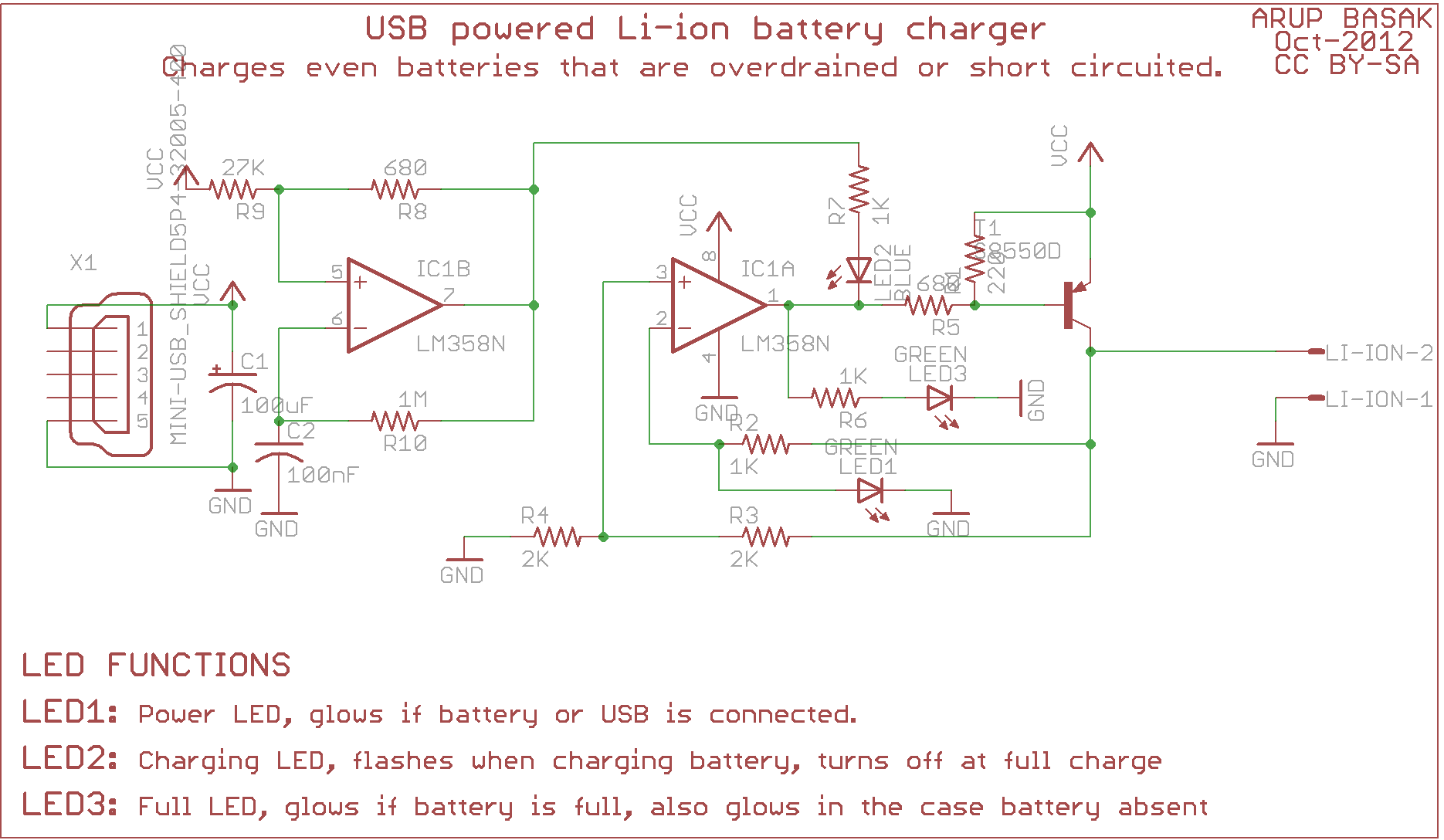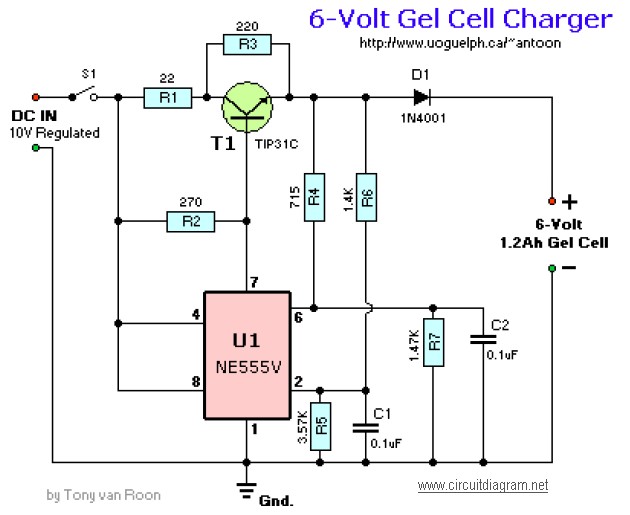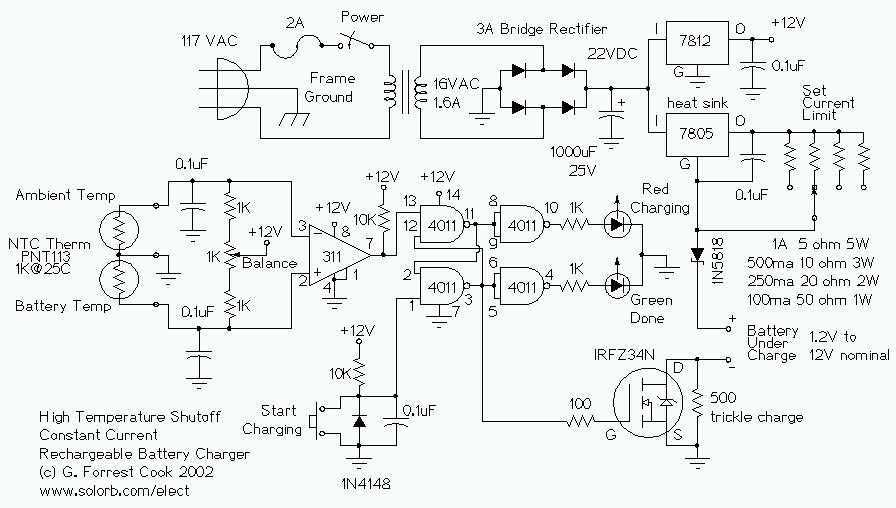
USB li-ion charger revision

A year ago, a circuit of a USB Li-ion charger based on the LM358 op-amp was shared. The circuit had some issues reported by commentators, including incorrect LED orientation. It is advised not to post email addresses or phone numbers in the comment box, and to only enter email addresses in the designated email field. Comments are moderated, which may cause a delay in their appearance on the site. Offensive comments will be removed. For requests regarding custom circuits, a specific form for circuit requests should be used. The circuit was built as shown in the schematic, with the exception of using a barrel jack connector and a 5V switching power supply from SparkFun. When testing the voltage from the charging part of the circuit, a reading of 3.77 volts was obtained, which raised questions about its correctness. A dead Nokia 3.6V battery was charged successfully, but a newer Samsung 3.7V battery did not charge. The Samsung battery read 3.99V when fully charged and 3.79V when partially charged. Connecting it to the charger did not yield any results, leading to concerns that the charger was outputting insufficient voltage (3.77V). There is a desire to utilize the full power of the S8550 transistor, targeting a charging current of 1 to 1.5 amperes. A robust 5V power supply capable of delivering about 2A is available. Adjustments to the schematic are requested to achieve the desired current for charging high-capacity 18650 Li-Ion cells. Additionally, it was noted that removing LED 1 significantly increased the voltage output, but the current was still low at 80mA, which is below expectations. Questions arose regarding the circuit on a breadboard, with an output voltage of approximately 3.6V, which might be normal if the LED remains lit until the battery reaches full charge. It was mentioned that some chargers have an output of 4.2V with 10% of the current. The user is self-learning electronics and seeks assistance for their project. The batteries used are two 3.7V 3000mAh cells connected in parallel. There is also a consideration of using a PNP transistor to activate a Darlington or other current-boosting transistor (with the PNP collector connected to the NPN base), particularly since the TIP102 Darlington is widely available at retailers like RadioShack. Additionally, a MC34063 boost converter has been added to step up from 3.7V to 5.5V to create a USB female jack for a battery backup charger, as well as a 6V solar panel input for sunny days.
The USB Li-ion charger circuit utilizing the LM358 op-amp is designed to charge lithium-ion batteries, particularly the 18650 cells, through a USB interface. The circuit operates by regulating the voltage and current supplied to the battery, ensuring safe and efficient charging. The LM358 op-amp serves as a voltage comparator and controller, maintaining the output voltage at an optimal level for lithium-ion batteries, typically around 4.2V when fully charged.
To address the issues reported, particularly the LED orientation and output current, modifications can be made to the circuit. The output voltage can be increased by ensuring that the feedback loop of the op-amp is correctly configured, allowing for a higher voltage output. If the output is only reaching 3.77V, it may indicate that the op-amp is not being driven correctly or that the power supply voltage is insufficient.
For achieving a charging current of 1 to 1.5 amperes, the circuit can be enhanced by integrating a power transistor, such as the S8550, to handle the higher current demands. The S8550 can be configured as a switch, controlled by the op-amp output, allowing it to drive the load with the necessary current. Additionally, using a Darlington pair like the TIP102 can further amplify the current, ensuring that the circuit can deliver the required charging current to the 18650 cells.
The inclusion of a boost converter, such as the MC34063, is a practical approach to stepping up the voltage from the battery to a usable level for USB devices. This circuit can be configured to increase the voltage from the 3.7V battery to 5.5V, suitable for powering USB devices. The solar panel input can also be integrated into the circuit, allowing for sustainable charging options during sunny conditions.
Overall, careful attention to the configuration and components used in the circuit will ensure that it functions effectively for charging lithium-ion batteries while accommodating the user's requirements for higher current output and versatility in power sources.An year ago, I`ve shared a circuit of USB li-ion charger based on LM358opamp. The circuit had some problems as reported by commentators that inclide wrong direction of LEDs. Don`t post your email or phone number in the comment box. Only put email address in the email field. Comments are moderated so it may take time for them to appear on the site. Offensive comments will be deleted. If this is a request for custom circuit, then use the wish a circuit form. I`ve built your circuit just as you show in your schematic, with the exception that I`m using a barrel jack connector, and a 5V switching power supply purchased from Sparkfun. com. When I test the voltage coming from the part of your circuit that you use to charge the battery, it`s reading 3.
77 Volts is this correct I had a dead` (measure 0V) Nokia 3. 6 battery and the circuit seemed to work. However, when trying to charge a newer Samsung 3. 7V, it doesn`t seem to work. When fully charged, the battery reads 3. 99V. I put it back in the phone until it was about 3/4 full which it then reads 3. 79V. When I connect it to the charger, it doesn`t seem to do anything. Is this because the charger is outputting less voltage (3. 77V) I would like to use full power of s8550, it means a 1, 5 ampere charging current. I have strong 5V power supply, which can deliver about 2A of current. How can I change Your schematic, to obtain current of 1 to 1, 5 ampere I need such a high current, to charge high capacity 18650 Li-Ion cells. Thanks in advance for Your reply. my output power was very low but when i removed LED 1 the voltage a lot more to what i would like. However i am only getting a 80mA out but i would like something a lot higher. I just have a question, i done this circuit on my breadboard, but my exit tension is something like 3, 6v is this normal that`s because the finish led light up until my battery reach 100% of charge.
maybe 30% or 40% I`ve read somewhere on internet that this chargers has a 4, 2v and 10% of the current on output I`m alone-home-learning electronics and hope your help for my project. by the way, my batteries are 2x 3, 7v 3000mah parallel connected. Also would it be plausable to use the pnp to switch on a darlington or other current boosting transistor.
(pnp collector to npn base). Only because the tip 102 darlington is quite common at places like radioshack. I also added a mc34063 simple boost from 3. 7 to 5. 5v to a usb female jack to turn this into a sweet battery backup charger. As well as a 6v solar panel input for sunny days. 🔗 External reference
The USB Li-ion charger circuit utilizing the LM358 op-amp is designed to charge lithium-ion batteries, particularly the 18650 cells, through a USB interface. The circuit operates by regulating the voltage and current supplied to the battery, ensuring safe and efficient charging. The LM358 op-amp serves as a voltage comparator and controller, maintaining the output voltage at an optimal level for lithium-ion batteries, typically around 4.2V when fully charged.
To address the issues reported, particularly the LED orientation and output current, modifications can be made to the circuit. The output voltage can be increased by ensuring that the feedback loop of the op-amp is correctly configured, allowing for a higher voltage output. If the output is only reaching 3.77V, it may indicate that the op-amp is not being driven correctly or that the power supply voltage is insufficient.
For achieving a charging current of 1 to 1.5 amperes, the circuit can be enhanced by integrating a power transistor, such as the S8550, to handle the higher current demands. The S8550 can be configured as a switch, controlled by the op-amp output, allowing it to drive the load with the necessary current. Additionally, using a Darlington pair like the TIP102 can further amplify the current, ensuring that the circuit can deliver the required charging current to the 18650 cells.
The inclusion of a boost converter, such as the MC34063, is a practical approach to stepping up the voltage from the battery to a usable level for USB devices. This circuit can be configured to increase the voltage from the 3.7V battery to 5.5V, suitable for powering USB devices. The solar panel input can also be integrated into the circuit, allowing for sustainable charging options during sunny conditions.
Overall, careful attention to the configuration and components used in the circuit will ensure that it functions effectively for charging lithium-ion batteries while accommodating the user's requirements for higher current output and versatility in power sources.An year ago, I`ve shared a circuit of USB li-ion charger based on LM358opamp. The circuit had some problems as reported by commentators that inclide wrong direction of LEDs. Don`t post your email or phone number in the comment box. Only put email address in the email field. Comments are moderated so it may take time for them to appear on the site. Offensive comments will be deleted. If this is a request for custom circuit, then use the wish a circuit form. I`ve built your circuit just as you show in your schematic, with the exception that I`m using a barrel jack connector, and a 5V switching power supply purchased from Sparkfun. com. When I test the voltage coming from the part of your circuit that you use to charge the battery, it`s reading 3.
77 Volts is this correct I had a dead` (measure 0V) Nokia 3. 6 battery and the circuit seemed to work. However, when trying to charge a newer Samsung 3. 7V, it doesn`t seem to work. When fully charged, the battery reads 3. 99V. I put it back in the phone until it was about 3/4 full which it then reads 3. 79V. When I connect it to the charger, it doesn`t seem to do anything. Is this because the charger is outputting less voltage (3. 77V) I would like to use full power of s8550, it means a 1, 5 ampere charging current. I have strong 5V power supply, which can deliver about 2A of current. How can I change Your schematic, to obtain current of 1 to 1, 5 ampere I need such a high current, to charge high capacity 18650 Li-Ion cells. Thanks in advance for Your reply. my output power was very low but when i removed LED 1 the voltage a lot more to what i would like. However i am only getting a 80mA out but i would like something a lot higher. I just have a question, i done this circuit on my breadboard, but my exit tension is something like 3, 6v is this normal that`s because the finish led light up until my battery reach 100% of charge.
maybe 30% or 40% I`ve read somewhere on internet that this chargers has a 4, 2v and 10% of the current on output I`m alone-home-learning electronics and hope your help for my project. by the way, my batteries are 2x 3, 7v 3000mah parallel connected. Also would it be plausable to use the pnp to switch on a darlington or other current boosting transistor.
(pnp collector to npn base). Only because the tip 102 darlington is quite common at places like radioshack. I also added a mc34063 simple boost from 3. 7 to 5. 5v to a usb female jack to turn this into a sweet battery backup charger. As well as a 6v solar panel input for sunny days. 🔗 External reference





